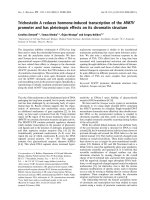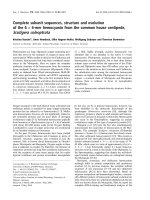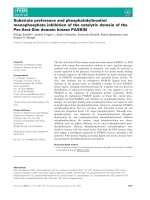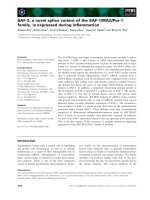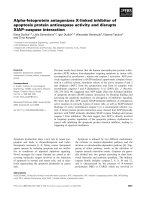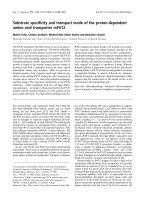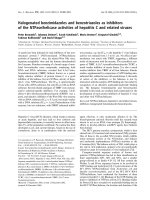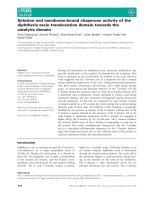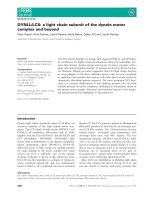Báo cáo khoa học: Glucose oxidase prevents programmed cell death of the silkworm anterior silk gland through hydrogen peroxide production ppt
Bạn đang xem bản rút gọn của tài liệu. Xem và tải ngay bản đầy đủ của tài liệu tại đây (411.67 KB, 10 trang )
Glucose oxidase prevents programmed cell death of the
silkworm anterior silk gland through hydrogen peroxide
production
Hiroto Matsui
1
, Motonori Kakei
2
, Masafumi Iwami
1,2
and Sho Sakurai
1,2
1 Division of Biological Sciences, Graduate School of Natural Science and Technology, Kanazawa University, Japan
2 Division of Life Sciences, Graduate School of Natural Science and Technology, Kanazawa University, Japan
Introduction
Programmed cell death (PCD) plays an important role
in the elimination of cells and tissues as part of the
progression of animal development. In insects, larval-
specific tissues degenerate during metamorphosis in
response to 20-hydroxyecdysone (20E), an active form
of ecdysteroid. The induction of PCD by 20E has been
extensively studied in the salivary glands of Drosoph-
ila melanogaster [1], the intersegmental muscles [2] and
prothoracic glands of Manduca sexta [3], and the ante-
rior silk glands (ASGs) of Bombyx mori [4,5].
The B. mori ASG is a tubular organ consisting of a
single layer of cells, and acts as a spinning apparatus
for secreting silk thread, which is composed of two dif-
ferent proteins produced in the middle and posterior
silk glands. The ASG is eliminated at the end of the
larval stage through PCD in response to the meta-
morphic rise in the 20E concentration [4]. The ASG
becomes competent to respond to 20E undergoing
PCD late on day 5 of the fifth (last) instar stage, and
exhibits full competence after the onset of spinning on
day 6, but ASGs before the middle of day 5 do not
respond to 20E [6].
Lepidopteran larval epidermis and wing disks lose
their sensitivity to juvenile hormone after the change
Keywords
glucose oxidase; hydrogen peroxide; insect;
programmed cell death; silk gland
Correspondence
S. Sakurai, Division of Life Sciences,
Graduate School of Natural Science and
Technology, Kanazawa University, Kanazawa
920-1192, Japan
Fax: +81 76 264 6215
Tel: +81 76 264 6250
E-mail:
(Received 15 November 2010, revised
16 December 2010, accepted 21 December
2010)
doi:10.1111/j.1742-4658.2010.07996.x
During pupal metamorphosis, the anterior silk glands (ASGs) of the silk-
worm Bombyx mori degenerate through programmed cell death (PCD),
which is triggered by 20-hydroxyecdysone (20E). 20E triggers the PCD of
the ASGs of day 7 fifth instar (V7) larvae but not that of V5 larvae. When
V7 ASGs were cocultured with V5 ASGs in the presence of 20E, neither
culture of ASGs underwent PCD. The 20E-induced PCD of V7 ASGs was
also inhibited when they were incubated in conditioned medium that was
prepared by incubating V5 ASGs for 48 h, an indication that V5 ASGs
released an inhibitor of 20E-induced PCD during incubation. The inhibitor
was purified from conditioned medium and identified as glucose oxidase
(GOD). GOD catalyzes the oxidation of glucose to gluconolactone, and
generates hydrogen peroxide as a byproduct. We found that hydrogen per-
oxide is the molecule that directly inhibits the action of 20E and may act
to protect the ASGs from early execution of PCD during the feeding stage.
GOD was localized in the inner cavity of the gland, and was discharged to
the outside of the ASGs with the silk thread at the onset of spinning. Thus,
the spinning behavior, occurring at the beginning of the prepupal period,
plays an important role in controlling the time at which ASGs undergo
PCD in response to 20E.
Abbreviations
ASG, anterior silk gland; BHR3, Bombyx hormone receptor 3; BR-C Z1, broad complex Z1; CM, conditioned medium; DHR3, Drosophila
hormone receptor 3; GOD, glucose oxidase; NOX, NADPH oxidase; PCD, programmed cell death; RpL3, ribosomal protein L3;
20E, 20-hydroxyecdysone.
776 FEBS Journal 278 (2011) 776–785 ª 2011 The Authors Journal compilation ª 2011 FEBS
in commitment that occurs in the fifth instar, and the
pupally committed tissues are capable of responding to
20E with pupal differentiation. Whereas the ASGs lose
their sensitivity to juvenile hormone on approximately
day 4 of the fifth instar [6], they do not exhibit respon-
siveness to 20E until late on day 6. This observation
led to the hypothesis that an unknown factor(s) may
be involved in the control of PCD execution in addi-
tion to 20E and juvenile hormone.
When we cocultured ASGs from day 5 fifth instar
(V5) larvae and V7 larvae with 20E, we found that
neither group of ASGs underwent PCD. This result
indicates that V5 ASGs inhibit the 20E-induced PCD
of V7 ASGs. In addition, when V7 ASGs were cul-
tured with 20E in conditioned medium (CM) that was
prepared by incubating V5 ASGs for 48 h in the
absence of 20E, they did not undergo PCD. This result
indicates that an inhibitory factor was released from
V5 ASGs into the medium and thereby prevented V5
ASGs from responding to 20E.
Purification and identification of the inhibitory fac-
tor revealed that it was glucose oxidase (GOD). GOD
(EC 1.1.3.4.) is an oxidoreductase that catalyzes the
oxidation of glucose to gluconolactone, and generates
hydrogen peroxide as a byproduct. Its presence in ani-
mals has only been observed in insects. In insects,
GOD occurs as a component of salivary secretions in
various lepidopterans and hymenopterans [7]. GOD,
produced by the adult hypopharyngeal gland of
Apis mellifera, is suggested to act as an antibacterial
substance in honey, through hydrogen peroxide forma-
tion. In addition, the suggested natural functions of
GOD include the detoxification of noxious plant
components involved in plant defense responses [7]. In
contrast, the in vivo function of GOD has not yet been
determined.
In the present study, we show that, during the incu-
bation of V5 ASGs, hydrogen peroxide is generated
and glucose is consumed in Grace’s medium, and this
hydrogen peroxide is the primary substance involved
in inhibiting 20E-induced PCD. As the silkworms
entered the prepupal stage, GOD disappeared from the
ASG inner cavity, owing to the onset of spinning,
which caused the release of GOD from ASGs along
with the silk proteins. Thus, ASGs control the timing
of their own degeneration by preserving GOD.
Results
The presence of the PCD inhibitor in V5 ASGs
V7 ASGs undergo PCD when cultured with 1 lm 20E
(Fig. 1A,G), but V5 ASGs do not undergo PCD under
the same conditions [6]. When V7 ASGs were cocul-
tured with V5 ASGs, V7 ASGs did not undergo PCD
(Fig. 1B,H). Such inhibition of PCD was duplicated
with the use of CM in which V5 ASGs had been
F
f
0
1
2
3
4
5
6
PCD
sc
o
r
e
Culture period (h)
024487296120144
V7 + V5
V7 + V7
B
V7
V5
0
1
2
3
4
5
6
A
PCD score
Culture period (h)
024487296120144
0
1
2
3
4
5
6
PCD
score
Culture period (h)
024487296120144
x1
x2
D
0
1
2
3
4
5
6
PCD score
Culture period (h)
024487296120144
x1
x2
C
0
0.2
0.4
0.6
0.8
1
Unit/gland
day
IV1234V01234567
E
G
g
Hh I i
Fig. 1. PCD progression of V7 ASGs induced by 20E in vitro and
PCD inhibition of V7 ASGs by V5 ASGs. PCD progression is
expressed as an increase in PCD score [4]. (A) V7 ASGs responded
to 20E by undergoing PCD, but V5 ASGs did not. (B) One V7 ASG
was cultured with a V5 ASG (V7 + V5) or two V7 ASGs (V7 + V7)
in 0.6 mL of Grace’s medium with 20E. (C) The presence of the
inhibitory factor in CM prepared by incubating V5 ASGs in 0.3 mL
of Grace’s medium without 20E for 48 h (V5 CM). The activity was
assessed for the undiluted CM (·1) or CM doubly diluted with
Grace’s medium (·2). (D) The inhibitory activity in V5 ASGs was
assessed from the crude extracts of V5 ASGs after adjustment of
the extract concentration to 0.5 (·2) or 1 (·1) ASG equivalent with
Grace’s medium. (E) Changes in the inhibitory activity in CM
through the fourth and fifth instar. The ordinate indicates the activ-
ity relative to that in V5 CM (1 U). (F,f) V7 ASGs at 144 h of culture
in Grace’s medium alone or (G,g) in Grace’s medium with 1 l
M
20E. (H,h) V7 ASGs were cocultured with V5 ASGs in Grace’s med-
ium with 20E or (I,i) cultured in V5 CM with 20E. (F–I) Light micros-
copy and (f–i) 4¢,6-Diamidino-2-phenylindole staining to show
nuclear morphology. See [4] for a detailed description of nuclear
morphology (mean ± standard deviation; n = 12–24). Scale bar:
70 lm.
H. Matsui et al. Glucose oxidase prevents programmed cell death
FEBS Journal 278 (2011) 776–785 ª 2011 The Authors Journal compilation ª 2011 FEBS 777
incubated for 48 h (V5 CM). V7 ASGs did not
undergo PCD when cultured in V5 CM (Fig. 1C,I),
but twice-diluted V5 CM exhibited no inhibitory activ-
ity (i.e. all of the V7 ASGs exhibited PCD scores of 5–
6). These results indicate that V5 ASGs may release an
inhibitor of PCD. Furthermore, V5 ASGs also released
the inhibitor in NaCl ⁄ P
i
or Ringer’s solution for
insects (Fig. S1).
To examine whether the gland itself contains the
inhibitor, crude V5 ASG extracts were subjected to the
inhibitor assay, either directly or after double dilution.
The extracts exhibited inhibitory activity similar to
that of V5 CM, indicating that V5 ASGs contained
the inhibitor (Fig. 1D).
Changes of inhibitor-producing activity during
the larval period
We examined the inhibitor activity in the CM of ASGs
from day 1 of the fourth instar to day 7 of the fifth
instar (Fig. 1E). The assays indicated that IV1–IV4
and V7 CM exhibited little or no inhibitory activity,
because the CM of five glands from these days did not
inhibit PCD. In V6 ASGs, CM prepared with three
ASGs had 1 unit of activity, indicating that V6 CM
contained one-third of a unit of activity.
Purification and identification of the PCD
inhibitor
After the debris was removed by centrifugation, the
V3 CM prepared with NaCl ⁄ P
i
was concentrated and
subjected to a two-step HPLC separation. The chro-
matographic peak at 12.9 min on a Mono Q column
exhibited inhibitory activity (Fig. 2A). The fractions
corresponding to the active peak were then loaded
directly onto a Superdex 200 column, and the fractions
with retention times of 18–24 min were found to have
PCD inhibitory activity (Fig. 2B). Those fractions were
combined and subjected to SDS ⁄ PAGE, which
revealed a major band at 80 kDa and a minor band at
120 kDa (Fig. 2C). The 120-kDa band was the main
component of the peak at 24.3 min, but the peak
fraction did not exhibit the inhibitory activity.
Therefore, the 80-kDa band was subjected to amino
acid sequencing.
Ten peptides obtained by trypsin digestion were suc-
cessfully sequenced (Fig. S2), and the comparison of
these sequences with 14 000 proteins in SilkDB (http://
silkworm.genomics.org.cn/) indicated similarity to a
novel protein, with a sequence coverage value of 100%
and a score of 1269 (BGIBMGA012872). The amino
acid sequence of the novel protein was subsequently
submitted to blast analysis with the DNA Data Bank
of Japan (DDBJ; The
purified protein exhibited a strong similarity to a Heli-
coverpa armigera GOD-like enzyme, with an identity
value of 66% and a score of 800, indicating that the
inhibitor of PCD may be B. mori GOD.
Inhibitory activity of fungal and B. mori GOD
V7 ASGs were cultured with 20E in Grace’s medium
containing the GOD of Aspergillus niger. This GOD
inhibited PCD at a concentration of 0.39 lm, and the
inhibition was more prominent at 0.78 lm (Fig. 3A),
indicating that A. niger GOD possessed PCD inhibi-
tory activity.
We examined the GOD activity in the extracts of V3
ASGs, V3 CM, and the active fraction of Superdex 200
200
116
98
66
C
1234
kDa
Absorbance (280 nm)
0
0.16
0.32
0
50
100
01020
Retention time (min)
A
0.7 M NaCl (%)
020
Retentiontime(min)
40
0
0.08
0.16
B
Absorbance (280 nm)
Fig. 2. Purification of the PCD inhibitor by two chromatographic steps. The eluent was monitored at 280 nm. (A) Mono Q column chromato-
gram. The broken line denotes the NaCl gradient. The inhibitor was eluted at the peak indicated by cross-hatching. (B) Separation on a
Superdex 200 column. The cross-hatched fraction (18–24 min) exhibited the inhibitory activity. (C) SDS ⁄ PAGE (6% polyacrylamide) separa-
tion of the active fraction in (B). Approximately 5 lg of protein was loaded in each lane. Lane 1: CM prepared by incubation of 2000 ASGs.
Lane 2: upper phase of ultrafiltration of the CM. Lane 3: the active peak in (A). Lane 4: the active fraction in (B).
Glucose oxidase prevents programmed cell death H. Matsui et al.
778 FEBS Journal 278 (2011) 776–785 ª 2011 The Authors Journal compilation ª 2011 FEBS
(Fig. 2B), all of which were adjusted to contain 1 unit
of inhibitory activity. GOD activities in the extracts,
CM and the active fraction were 67.5 ± 10.6,
67.7 ± 8.3 and 56.9 ± 3.7 nmolÆmin
)1
, respectively
(Fig. 3B). The activity of 0.78 lm A. niger GOD was
499.7 ± 13 nmolÆmin
)1
. Among the V3 larval tissues,
GOD activity was found primarily in ASGs. The activ-
ity in middle silk glands was very low, and no activity
was detected in the other tissues examined (Fig. 3C).
Changes in GOD activity in CM indicated that the
activity increased from day 0 to day 4, peaked at
day 4, and decreased to a low level on day 6 (Fig. 3D).
A similar result was obtained for the ASG extracts
(Fig. 3E).
We next examined GOD gene expression for the
three parts of V0 silk glands, and found that the gene
was strongly and equally expressed in ASGs and mid-
dle silk glands but not in posterior silk glands
(Fig. 3C, inset). During the fourth and fifth instar,
GOD expression in ASGs was strong in IV2 and V0
larvae, and weak but detectable on the other days
(Fig. 3F). The change in the amount of GOD enzyme
protein did not directly correspond to the change in
gene expression; the enzyme level increased after the
decline of gene expression to a low level, and peaked
on day 3 (Fig. 3F,G).
Mechanism of PCD inhibition by GOD
GOD catalyzes the oxidation of glucose to gluconolac-
tone, and produces hydrogen peroxide as a byproduct.
We examined the substrate specificity of B. mori GOD
with the use of crude V3 ASG extracts, and found that
only glucose serves as a substrate (Fig. S3). Prior to
examining whether the inhibitory activity of GOD was
caused by the enzymatic activity of GOD, we needed
to reproduce the 20E-induced PCD in medium without
glucose (Grace’s medium contains 4.7 mm glucose).
Thus, we cultured V7 ASGs with 20E in Ringer’s solu-
tion, and found that the ASGs underwent PCD. Next,
V3 ASGs were cultured with 20E in Ringer’s solution,
in which all ASGs attained PCD scores of 4–6
(Fig. 4A). However, PCD was not induced in a 1 : 1
mixture of Ringer’s solution and Grace’s medium
(Fig. 4A), an indication that GOD may inhibit PCD
though an enzymatic reaction, using the glucose in
Grace’s medium. To examine this issue, we cultured
V3 ASGs in Ringer’s solution with 1 lm 20E and
0.39 µ
0.78
0
1
2
3
4
5
6
PCD score
0 24487296120144
A
Culture period (h)
Stage (day)
IV234V01234567
0
100
200
300
400
E
0
100
200
Stage (day)
IV2 3 4 V0 1 2 3 4 5 6 7
D
Ext
CM
AnG
O
D
PS
B
0
200
400
600
MSG
PSG
Hemolymph
Salivary gland
Mid
gu
t
C
ASG
0
100
200
H
2
O
2
(nmol·min
–1
·mg
–1
)
H
2
O
2
(nmol·min
–1
·mL
–1
)H
2
O
2
(nmol·min
–1
)
H
2
O
2
(nmol·min
–1
·mg
–1
)
F
V0 V2 V3 V5 V6 V7
GOD
RpL3
IV2 IV4
GOD
protein
R
ela
t
iv
e
i
nte
n
sity
V0 V2 V3 V5 V6 V7IV2 IV4
G
Fig. 3. Characterization of GOD. (A) Fungal
GOD inhibits 20E-induced PCD. V7 ASGs
were cultured with 20E in Grace’s medium
containing A. niger GOD (AnGOD). (B) Pro-
duction of hydrogen peroxide by the crude
extracts of V3 ASGs (Ext), V3 CM (CM),
0.78 l
M of AnGOD, and the active fraction
from the Superdex 200 column (PS). Each
sample contained 1 unit of inhibitory activity,
which is equivalent to that in the V5 CM
prepared from one V5 ASG. (C) GOD activity
in the extracts of various tissues of V3 lar-
vae and (C, inset) GOD expression in the
ASG, the middle silk gland (MSG) and the
posterior silk gland (PSG) of V0 larvae, as
determined by RT-PCR. (D) Developmental
changes of B. mori GOD activity in CM,
which was prepared using Ringer’s solution,
and (E) in ASG extracts [mean ± standard
deviation, n = 13 for (A) and n = 3 for
(B)–(E)]. (F) Developmental profile of GOD
expression, as determined by RT-PCR, and
the presence of GOD protein, as deter-
mined by western blotting. Gene expression
in IV4 and V2–V7 larvae was very faint but
detectable. (G) Relative intensity of GOD
gene expression (open column) and amount
of GOD protein (closed column), depicted
on the basis of the data in (F).
H. Matsui et al. Glucose oxidase prevents programmed cell death
FEBS Journal 278 (2011) 776–785 ª 2011 The Authors Journal compilation ª 2011 FEBS 779
various concentrations of glucose (Fig. 4B). The PCD
score decreased with increases in glucose concentra-
tion, and PCD was entirely inhibited at 2 mm glucose.
These results suggested that hydrogen peroxide,
gluconolactone or both may inhibit PCD. Thus, we
cultured V7 ASGs with 20E in Grace’s medium
supplemented with hydrogen peroxide or gluconolac-
tone. Hydrogen peroxide (3 mm) interfered with the
progression of PCD, but 10 mm gluconolactone did
not inhibit PCD (Fig. S4). Therefore, hydrogen
peroxide may be the substance responsible for PCD
inhibition.
To confirm this finding, we added 0.36 lm catalase
to Ringer’s solution containing 2 mm glucose, and cul-
tured V3 ASGs with 20E. In this medium, PCD was
not inhibited (Fig. 4C), supporting the notion that
hydrogen peroxide is the factor that inhibits PCD.
During the incubation of V3 ASGs, the concentration
of hydrogen peroxide increased, and reached 268.1 ±
88.1 lm at 12 h (Fig. 4D). By contrast, the presence of
catalase inhibited the increase in hydrogen peroxide
concentration throughout the incubation period.
Combining these observations, we concluded that the
production of hydrogen peroxide by the enzymatic
reaction of GOD results in the inhibition of PCD.
Selective suppression of 20E-inducible genes by
hydrogen peroxide
V7 ASGs were incubated for various lengths of time in
V3 CM, which was prepared with Ringer’s solution
and adjusted to have 1 unit of inhibitory activity with
Grace’s medium. The ASGs were then transferred to
fresh Grace’s medium with 20E, and cultured for
144 h. Under these conditions, a 3-h incubation in CM
sufficiently inhibited the gland’s responsiveness to 20E
(Fig. 5A). Alternatively, V7 ASGs were incubated with
3or6mm hydrogen peroxide for 0–6 h, and then cul-
tured in Grace’s medium with 20E. In these conditions,
a 3-h incubation with 6 mm hydrogen peroxide inhib-
ited PCD (Fig. 5B). In addition, these results indicated
that the inhibition was irreversible, because PCD did
not proceed after the transfer to Grace’s medium. To
examine whether this irreversible inhibition was caused
by the toxic effects of hydrogen peroxide, the expres-
sion of early and early–late genes was determined in
four different media (Fig. 5C). Among the genes exam-
ined, expression levels of E75A, broad complex Z1
(BR-C Z1) and Bombyx hormone receptor 3 (BHR3)
were greatly reduced, but the expression of other genes
was not significantly altered. Because these three genes
were suggested to be involved in the early phase of
PCD progression in the prepupal period in B. mori [8],
the inhibition of PCD may not be attributable to the
toxicity of hydrogen peroxide.
Explanation for missing GOD activity in V7 ASGs
GOD activity in ASGs was rapidly lost from day 5 to
day 7 (Fig. 3D). Thus, questions remain regarding the
cause of this decreased GOD activity. GOD activity
was found in ASG extracts, indicating that GOD may
be present in ASG cells, the inner cavity, or both, and
that GOD is released into the medium during incubation,
400
300
200
100
0
H
2
O
2
(µM)
013122448
Culture period (h)
Glu 2 mM
Cat 0.36 µM
Glu + Cat
0
1
2
3
4
5
6
PCD score
Culture
p
eriod
(
h
)
0 24 48 72 96 120 144
RS
RS + 20E
RS + GM
RS + GM + 20E
PCD
score
0
1
2
3
4
5
6
Response (%)
100
80
60
40
20
0
A
0
1
2
3
4
5
6
PCD score
00.5
Glucose (mM)
11.52
B
C
D
Fig. 4. Hydrogen peroxide causes PCD inhi-
bition. (A) V3 ASGs were cultured with 20E
in Ringer’s solution (RS) or a 1 : 1 mixture
of Ringer’s solution and Grace’s medium
(GM). The ordinate indicates the percentage
of the glands that exhibited each score at
the end of the culture for 144 h. (B) Inhibi-
tion of PCD by glucose in the medium. V3
ASGs were cultured in Ringer’s solution
with 20E and various concentration of glu-
cose for 144 h. (C) V3 ASGs were cultured
with 20E in Ringer’s solution containing glu-
cose, catalase (Cat), or both. (D) Generation
of hydrogen peroxide by incubation of V3
ASGs in Ringer’s solution (black), Ringer’s
solution with 2 m
M glucose (white) or
Ringer’s solution with 2 m
M glucose and
0.36 l
M catalase (gray) for the indicated
time periods [mean ± standard deviation;
n = 12 (A–C) and n = 3 (D)].
Glucose oxidase prevents programmed cell death H. Matsui et al.
780 FEBS Journal 278 (2011) 776–785 ª 2011 The Authors Journal compilation ª 2011 FEBS
probably through the cut surface of the cultured
ASGs. In addition, ASGs obtained late on day 5 did
not complete PCD in Grace’s medium, but ASGs from
the middle of day 6 did complete PCD [6]. During this
period, larvae begin to spin cocoons. Therefore, we
assumed that GOD may be discarded with silk thread
through spinning. To test this hypothesis, we interfered
with spinning by occluding spinnerets with paraffin in
the scotophase of V5 larvae (before the onset of spin-
ning) and V6 larvae (after the onset). Then, ASGs
were dissected on day 8 and cultured in Grace’s med-
ium with 20E. The occlusion on day 5 inhibited the
PCD of V8 ASGs, whereas occlusion on day 6 failed
to do so (Fig. 6A). In addition, the ASGs of larvae
whose spinnerets were occluded on day 5 retained
GOD activity, but the ASG extracts from larvae trea-
ted on day 6 did not (Fig. 6B). These results indicated
the importance of spinning to the loss of GOD activity
in ASGs.
Finally, we examined the localization of the GOD
enzyme by active staining for the silk glands of V3 lar-
vae; ASGs were stained reddish–brown (Fig. 6C,c).
The stained site in the ASG was restricted to the inner
cavity, but ASG cells were not stained. Middle silk
glands appeared to be stained faintly at their most
anterior region, near the boundary between the ASG
and the middle silk gland (Fig. 6D,d). The main bodies
of middle silk glands (Fig. 6E,e) and posterior silk
glands (Fig. 6F,f) were not stained at all. We also
stained fragments of cocoons with o-dianisidine, and
observed that the outside layer of the cocoon was
partly stained (Fig. 6G,g).
Discussion
After the onset of spinning, ASGs undergo cell death
in response to 20E treatment in vitro, but they do not
do so before spinning [6]. Although such differences in
responsiveness to 20E have been considered to be
caused by a lack of competence to respond to 20E [9],
our results clearly indicate that the unresponsiveness of
ASGs before spinning is caused by a PCD inhibitory
factor produced by the glands themselves. The most
striking findings of this study were that the PCD inhib-
itory factor is GOD and that the substance responsible
for the inhibition of PCD is hydrogen peroxide.
–20E
+20E
RS-CM + 20E
H
2
O
2
+ 20E
EcR-A
EcR-B
USP-1
USP-2
E75A
E75B
E74A
E74B
BR-C Z1
BR-C Z
2
BR-C Z
4
BHR3
RpL3
C
6
R
e
s
p
o
n
se (%)
R
e
s
p
o
n
se (%)
0
20
40
60
80
100
1
3
Hours in CM
A
PCD
score
0
1
2
3
4
5
6
H
2
O
2
(mM)
Hours with H
2
O
2
3
6
3
0
3
3
6
3
6
6
0
20
40
60
80
100
B
Fig. 5. Minimum period of hydrogen peroxide incubation required for PCD inhibition and inhibition of 20E-inducible genes. (A) Two V3 ASGs
were incubated in 0.3 mL of Ringer’s solution, and then an equal volume of Grace’s medium was added. Immediately after preparation of
the mixed medium, V7 ASGs were incubated in the mixed medium with 20E for the indicated length of time, and then cultured in Grace’s
medium with 20E for 144 h. (n = 12) (B) V7 ASGs were incubated in Grace’s medium with 3 or 6 m
M hydrogen peroxide for 3 or 6 h with
20E, and then cultured in Grace’s medium with 20E for 144 h. (n = 12) (C) Effects of hydrogen peroxide on 20E-responsive gene expression.
V7 ASGs were incubated for 3 h in Grace’s medium without 20E ()20E), Grace’s medium with 20E (+20E), a 1 : 1 mixture of Grace’s med-
ium and V3 CM prepared by a 48-h incubation of two V3 ASGs in 0.3 mL of Ringer’s solution (RS-CM+20E), or Grace’s medium with 20E
and 6 m
M hydrogen peroxide (H
2
O
2
+ 20E). EcR, ecdysone receptor; usp, ultraspiracle; BR-C, broad complex; BHR3, Bombyx hormone
receptor 3; RpL3, ribosomal protein L3.
H. Matsui et al. Glucose oxidase prevents programmed cell death
FEBS Journal 278 (2011) 776–785 ª 2011 The Authors Journal compilation ª 2011 FEBS 781
Although hydrogen peroxide is classically considered
to be a toxic factor for cells, NADPH oxidase (NOX)
in mammalian cells generates reactive oxygen species,
including hydrogen peroxide, that play an important
role in the regulation of cell proliferation and growth
at nontoxic levels (i.e. nanomolar to micromolar level)
[10]. Prostate cancer cells produce substantial amounts
of reactive oxygen species, in part from stimulation of
NOX. Antioxidants or NOX inhibitors inhibit cell
proliferation, and instead induce apoptosis [11,12].
Furthermore, exogenous hydrogen peroxide inhibits
the activity of caspase-3 [13,14]. These observations
suggest that hydrogen peroxide regulates growth and
apoptosis in cancer cells. In B. mori fifth instars, the
ASGs notably increase in tissue size [15], and both the
amount of GOD protein and GOD activity increased,
indicating the involvement of GOD-produced hydro-
gen peroxide in the growth of ASGs. This phenome-
non also suppressed PCD induction by 20E, because
20E-induced PCD depends on the activation of a cas-
pase-3-like protein [5,16].
Culturing V7 ASGs in CM irreversibly inhibited
20E-induced PCD, and a 3-h incubation in V3 CM
was also sufficient for inhibition. Indeed, the treated
ASGs never exhibited any sign of the change in cellu-
lar and nuclear morphology specific to PCD or under-
went necrosis, even after 144 h in culture. The
incubation of V7 ASGs in V3 CM or with 6 mm
hydrogen peroxide for 3 h altered the expression of
ecdysone-responsive genes; large decreases in the
expression of E75A, BR-C Z1 and BHR3 were noted.
These genes are upregulated by 20E in V7 ASGs, and
are therefore suggested to be involved in the progres-
sion of PCD [8]. In the cell death of Drosophila
salivary glands, Drosophila hormone receptor 3 (DHR3)
is the key gene in the hierarchy of gene expression
induced by 20E [17]. During the expression of dopade-
carboxylase (the key enzyme for the melanization that
occurs shortly after every molting), MHR3,aManduca
homolog of DHR3, is the key transcriptional factor in
the sequential expression of 20E-induced gene,s result-
ing in enzyme expression. These findings indicate that,
among the genes inhibited by hydrogen peroxide in V7
ASGs, BHR3 may be the key gene involved in the
inhibition of PCD.
Expression of the GOD gene, as well as changes in
GOD activity and the amount of GOD protein, are
not directly connected to one another. In the fourth
instar, neither GOD protein nor GOD activity was
present, regardless of the high-level expression of the
GOD-encoding gene. In the fifth instar, GOD gene
expression was high on day 0 and reduced by day 2.
However, the amount of GOD protein and its enzy-
matic activity peaked on day 3. When performing wes-
tern blot analysis, we applied a fixed amount of total
protein from crude ASG extracts. If the GOD is pres-
ent as a proenzyme, post-translational modifications
may contribute to the increase in its enzymatic activity.
However, if this was the case with GOD, the signal
intensity of GOD in western blot would remain at the
original level. Thus, at present, there is no interpreta-
tion for the discrepancy between the above-mentioned
temporal changes.
GOD was localized to the inner cavity of ASGs,
suggesting that hydrogen peroxide may be generated in
the cavity and act on the cell surface facing the cavity.
Thus, the question is how the GOD substrate, glucose,
is provided in the cavity. The insect salivary gland con-
tains trehalose (a-d-glucopyranosyl-a-d-glucopyrano-
side), the major sugar in insect hemolymph [18].
Trehalase is present with the liquid silk in the silk
glands, indicating that trehalase is produced by the silk
gland cells and is localized to the cavity of ASGs
[19,20]. The silk gland and the salivary gland are
homologous organs [21], and both produce silk protein
[22]. Therefore, it is possible that trehalose is present
g
C
c
D
E
e
F
f
G
d
g
100
80
60
40
20
0
Response (%)
A
0
100
200
B
H
2
O
2
(
nmol·min
–1
·mg
–1
)
V5 V6
Fig. 6. GOD is discarded with the spinning of silk thread. Effects
of spinneret occlusion on the loss of GOD activity from ASGs.
Spinnerets of V5 or V6 larvae were occluded with paraffin, and
their ASGs were dissected on day 8 to examine their responses to
20E (A) and assess the GOD activity in ASG extracts (B). The ordi-
nates in (A) and (B) are the same as in Figs 4A and 3E, respectively
[mean ± standard deviation; n = 12 (A) and n = 3 (B)]. (C–G) Locali-
zation of GOD in V3 silk glands and a cocoon fragment, as deter-
mined by active staining of GOD with o-dianisidine, and (c–g)
control tissues incubated without o-dianisidine. (C,c) ASG, (D,d)
boundary between the ASG and the middle silk gland, as indicated
by an arrowhead, (E,e) the middle silk gland, and (F,f) the posterior
silk gland. (G,g) cutting surface of a cocoon.
Glucose oxidase prevents programmed cell death H. Matsui et al.
782 FEBS Journal 278 (2011) 776–785 ª 2011 The Authors Journal compilation ª 2011 FEBS
in the ASG inner cavity and serves as a substrate for
trehalase to produce glucose, from which GOD gener-
ates hydrogen peroxide. The available amount of tre-
halose, and therefore glucose, may be limited and may
therefore limit the hydrogen peroxide present in the
cavity.
ASGs at noon of day 6 respond to 20E in vitro by
undergoing cell death, whereas ASGs from the night
of day 5 (i.e. 12–18 h earlier) do not [6]. During this
period, larvae begin to spin cocoons, and the first step
of cocooning is the construction of a scaffold with silk
thread to keep the larvae in a position suitable for
completing the cocoon. The silk scaffold remains as
the floss around the completed cocoon, and GOD
activity was found to remain with the floss. This find-
ing indicates that the GOD enzyme in the ASG inner
cavity was released with the silk at the early spinning
stage. Because the onset of spinning on day 6 is
induced by 20E, 20E indirectly induces the responsive-
ness of ASGs to 20E. After discarding GOD through
spinning, ASGs exhibit overt responsiveness to 20E.
The finding that V3 ASGs underwent PCD in Ringer’s
solution with 20E shows that they acquire the respon-
siveness to 20E 3 days before the onset of spinning,
and their responsiveness is covered by GOD in the
ASG inner cavity. This may be a typical example of a
behavior that is directly involved in the regulation of
cellular events at the biochemical and molecular levels.
In conclusion, the elimination of GOD from ASGs
accompanies metamorphosis, and GOD thus plays a
critical role in the control of PCD timing.
Experimental procedures
Animals
B. mori larvae were reared and staged as previously
described [23]. V7 larvae that began spinning on day 6 of
photophase, followed by gut purge during the scotophase
of the same day, were used in the present study. ASGs were
obtained during the photophase of individual days.
Hormones and in vitro culture
20E (Sigma, St Louis, MO, USA) was dissolved in distilled
water (1 mgÆmL
)1
) and stored at )20 °C. ASGs were rinsed
with Grace’s insect cell culture medium (Invitrogen, Carls-
bad, CA, USA) and cultured individually in 0.3 mL of the
medium (pH 6.4, adjusted with NaOH) with 1 lm 20E in
24-well plates (Grainer Bio-One, Frickenhausen, Germany)
at 25 °C. The ASGs were observed every 24 h, and the
degree of PCD progression was scored according to the
changes in cellular morphology. This progression was
expressed with a PCD score of 0–6, where a score of 0 indi-
cates no change, and a score of 6 signifies completion of
PCD with the formation of apoptotic bodies [4]. Nuclear
morphology was observed by 4¢,6-diamidino-2-phenylindole
staining [5].
Preparation of CM
V3 or V5 ASGs were individually incubated for 48 h in
0.3 mL of Grace’s medium, NaCl ⁄ P
i
(137 mm NaCl,
2.7 mm KCl, 8.1 mm Na
2
HPO
4
, 1.47 mm KH
2
PO
4
,
pH 7.4), or Ringer’s solution (128 mm NaCl, 4.7 mm KCl,
1.9 mm CaCl
2
). After incubation, the medium was recov-
ered and stored at 4 ° C until use. After the incubation
period, the media were designated as CMs.
Crude ASG extraction
A fresh ASG was homogenized in 0.15 mL of Ringer’s
solution for assays of PCD inhibitory activity or 0.30 mL
of 20 mm phosphate buffer (24.4 mm Na
2
HPO
4
, 15.6 mm
NaH
2
PO
4
, pH 7.0) for GOD assays. The homogenates were
centrifuged at 15 000 g for 10 min at 4 °C. The resulting
supernatant was diluted twice with Grace,s medium for the
inhibitory activity assay or used directly for the GOD
assay. Protein quantities were determined with an RC DC
protein assay kit (Bio-Rad, Hercules, CA, USA).
PCD inhibitory activity assay
PCD inhibitory activity was assayed by culturing V7 ASGs
in Grace’s medium with 1 lm 20E for 144 h, and the degree
of PCD progression was recorded every day or at the end
of the culture period. One unit of inhibitory activity was
defined as the activity equivalent to that of the CM pre-
pared by incubating one V5 ASG in 0.3 mL of Grace’s
medium for 48 h (V5 CM). When the CM of one gland
had less than 1 unit of the activity, the number of glands
cultured in 0.3 mL of medium was increased to five. Con-
versely, the CM was diluted with Grace’s medium when the
CM of one gland exhibited 1 unit of activity.
Purification and identification of the inhibitor
CM (300 mL) was prepared by incubating 2000 individual
V3 ASGs in NaCl ⁄ P
i
. The CM was then centrifuged at
15 000 g for 10 min at 4 °C. The supernatants were pooled
and concentrated to 15 mL with a centrifugal filter (Ultra
YM-30; Amicon, Beverly, MA, USA). The concentrate was
applied to a Mono Q column (0.05 · 5 cm; GE Healthcare,
Little Chalfont, UK), equilibrated with 20 mm phosphate
buffer (33.6 mm Na
2
HPO
4
, 6.4 mm NaH
2
PO
4
, pH 7.5), and
eluted with a linear gradient of 0–0.7 m NaCl in phosphate
buffer at a flow rate of 0.8 mLÆmin
)1
. The active fraction
H. Matsui et al. Glucose oxidase prevents programmed cell death
FEBS Journal 278 (2011) 776–785 ª 2011 The Authors Journal compilation ª 2011 FEBS 783
was concentrated to 2.5 mL with an Ultra YM-30, sub-
jected to gel filtration (Superdex 200, 0.1 · 30 cm; GE
Healthcare) on a column equilibrated with phosphate buf-
fer containing 0.15 m NaCl at a flow rate of 0.5 mLÆmin
)1
,
and eluted under the same conditions. Eluates were col-
lected every 3 min, and the active fractions were combined
and concentrated to 1 mL. The concentrate was subjected
to 6% SDS ⁄ PAGE [24], and the gel was stained with
Coomassie Brilliant Blue R-250 without fixation. A protein
band was e xcised from t he gel and analyzed by MALDI-TOF
MS. MS ⁄ MS w as p erformed with an Applied Biosystems
4800 plus MALDI TOF ⁄ TOF Analyzer (Applied Biosystems,
Foster City, CA, USA). A saturated solution of a-cyano-
4-hydroxycinnamic acid in acetonitrile ⁄ water (3 : 7, v ⁄ v)
was used as the matrix.
GOD activity assay
GOD activity was determined by the o-dianisidine method
[25]. The reaction mixture (in a total volume of 1 mL)
contained 0.17 mm o-dianisidine-HCl (Sigma) in 20 mm
phosphate buffer (pH 7.0), 90 mmd-glucose, 60 UÆmL
)1
horseradish peroxidase (Sigma), and 34.5 lL of sample
solution in phosphate buffer. For the negative control,
34.5 lLof20mm phosphate buffer (pH 7.0) was used
instead of the sample solution. The reaction mixture was
incubated without sample addition at 35 °C for 5 min, and
samples were then added and incubated for 5 min; this was
followed by recording of absorbance at 500 nm. GOD
activity is expressed as the production rate of hydrogen
peroxide (nmolÆmin
)1
per mg protein for tissue extracts and
nmolÆmin
)1
per mL for CM).
Active staining of GOD
Tissues and cocoon fragments were incubated without sam-
ple solution in the above-mentioned reaction mixture at
35 °C for 15 min. After incubation, the tissues and frag-
ments were rinsed with Ringer’s solution and observed for
the localization of GOD, according to the reddish-brown
coloration caused by the oxidation of o-dianisidine.
RT-PCR
Total RNA was extracted from tissues [26] and treated with
RNase-free DNase (Promega, Madison, WI, USA). Com-
plementary DNA was prepared from 1 lg of total RNA
using anchored oligo-dT [5¢-(T)12(A ⁄ C ⁄ G)(A ⁄ C ⁄ G ⁄ T)-3¢]
and Reve Tra Ace reverse transcriptase (Toyobo, Osaka,
Japan). For RT-PCR, GOD cDNA was amplified for 35
cycles with the following primers: (forward, 5¢-AACGGC
CAGAGGTACACAAC-3¢; reverse, 5¢-GATTCAAACCCA
CTGGGAGA-3¢). RT-PCR targeting 20E-induced genes
was performed with the same primer sets as described in
[8]. RNA encoding ribosomal protein L3 (RpL3) was used
as an internal standard and amplified for 25 cycles. PCR
products were separated by agarose gel electrophoresis.
Western blot analysis
Western blot analysis was performed with 8% SDS ⁄ PAGE
[27]. The membrane was probed with a primary antibody
prepared from rabbits against a peptide (DASVMPS
QPTGNPQ) designed from the putative amino acid
sequence of B. mori GOD at a 1 : 250 dilution, and this
was followed by an incubation with horseradish peroxidase-
conjugated goat anti-(rabbit IgG) (Cell Signaling Technol-
ogy, Danvers, MA, USA) and detection with an ECL
Advance kit (GE Healthcare).
Acknowledgements
This work was supported by JSPS Grant-in-Aid for
Scientific Research 21380035 (to S. Sakurai).
References
1 Yin VP & Thummel CS (2005) Mechanisms of steroid-
triggered programmed cell death in Drosophila. Semin
Cell Dev Biol 16, 237–243.
2 Fahrbach SE, Nambu JR & Schwartz LM (2005) Pro-
grammed cell death in insect neuromuscular systems
during metamorphosis. In Comprehensive Insect Molecu-
lar Science (Gilbert LI, Iatrou K & Gill SS eds), Vol 2,
pp. 165–198. Elsevier Pergamon, Oxford.
3 Dai J-D & Gilbert LI (1997) Programmed cell death of
the prothoracic glands of Manduca sexta during pupal–
adult metamorphosis. Insect Biochem Mol Biol 27, 69–
78.
4 Terashima J, Yasuhara N, Iwami M & Sakurai S (2000)
Programmed cell death triggered by insect steroid hor-
mone, 20-hydroxyecdysone, in the anterior silk gland of
the silkworm, Bombyx mori. Dev Genes Evol 210, 545–
558.
5 Iga M, Iwami M & Sakurai S (2007) Nongenomic
action of an insect steroid hormone in steroid-induced
programmed cell death. Mol Cell Endocrinol 263, 18–28.
6 Kakei M, Iwami M & Sakurai S (2005) Death commit-
ment in the anterior silk gland of the silkworm, Bombyx
mori. J Insect Physiol 51, 17–25.
7 Wong CM, Wong KH & Chen XD (2008) Glucose
oxidase: natural occurrence, function, properties and
industrial applications. Appl Microbiol Biotechnol
78, 927–938.
8 Sekimoto T, Iwami M & Sakurai S (2006) Coordinate
responses of transcription factors to ecdysone during
programmed cell death in the anterior silk gland of the
silkworm, Bombyx mori. Insect Mol Biol 15, 281–292.
Glucose oxidase prevents programmed cell death H. Matsui et al.
784 FEBS Journal 278 (2011) 776–785 ª 2011 The Authors Journal compilation ª 2011 FEBS
9 Riddiford LM (1996) Juvenile hormone: the status of
its ‘status quo’ action. Arch Insect Biochem Physiol 32,
271–286.
10 Stone JR & Yang S (2006) Hydrogen peroxide: a signal-
ing messenger. Antioxid Redox Signal 8, 243–270.
11 Gunawardena K, Murray DK & Meikle W (2000)
Vitamin E and other antioxidants inhibit human
prostate cancer cells through apoptosis. Prostate 44,
287–295.
12 Brar SS, Corbin Z, Kennedy TP, Hemendinger R,
Thornton L, Bommarius B, Arnold RS, Whorton AR,
Sturrock AB, Huecksteadt TP et al. (2003) NOX5
NAD(P)H oxidase regulates growth and apoptosis in
DU 145 prostate cancer cells. Am J Physiol Cell Physiol
285, 353–369.
13 Hampton MB & Orrenius S (1997) Dual regulation of
caspase activity by hydrogen peroxide: implications for
apoptosis. FEBS Lett 414, 552–556.
14 Borutaite V & Brown GC (2001) Caspases are revers-
ibly inactivated by hydrogen peroxide. FEBS Lett 500,
114–118.
15 Julien E, Coulon-Bublex M, Garel A, Royer C, Cha-
vancy G, Prudhomme J-C & Couble P (2005) Silk gland
development and regulation of silk protein genes. In
Comprehensive Insect Molecular Science (Gilbert LI,
Iatrou K & Gill SS eds), Vol 2, pp. 369–386. Elsevier
Pergamon, Oxford.
16 Iga M, Manaboon M, Matsui H & Sakurai S (2010)
Ca
2+
-PKC-caspase 3-like protease pathway mediates
DNA and nuclear fragmentation in ecdysteroid-induced
programmed cell death. Mol Cell Endocrinol 321, 146–
151.
17 Lam G, Hall BL, Bender M & Thummel CS (1999)
DHR3 is required for the prepupal–pupal transition
and differentiation of adult structures during Drosoph-
ila metamorphosis. Dev Biol 212, 204–216.
18 Hori K (1975) Digestive carbohydrases in the salivary
gland and midgut of several phytophagous bugs. Comp
Biochem Physiol 50B, 145–151.
19 Shimada S (1975) Trehalase activity in the silk glands
of the silkworm, Bombyx mori (Lepidoptera: bombyci-
dae). Can Entomol 107, 1311–1314.
20 Shimada S & Hyashiya K (1975) Hydrolysis of sucrose
by the cocoon of the silkworm, Bombyx mori. Insect
Biochem 5, 653–657.
21 Tucker AS (2010) Salivary gland adaptations: modifica-
tion of the glands for novel uses. Front Oral Biol 14,
21–31.
22 Sehnal F & Sutherland T (2008) Silks produced by
insect labial glands. Prion 4, 145–153.
23 Sakurai S, Kaya M & Satake S (1998) Hemolymph
ecdysteroid titer and ecdysteroid-dependent develop-
mental events in the last-larval stadium of the silkworm,
Bombyx mori: role of low ecdysteroid titer in larval
pupal metamorphosis and a reappraisal of the head
critical period. J Insect Physiol 44, 867–881.
24 Laemmli KU (1970) Cleavage of structural proteins
during the assembly of the head of bacteriophage.
Nature 227, 680–685.
25 Bergmeyer HU, Gawehn K & Grassl M (1974) Enzymes
as biochemical reagents. In Methods of Enzymatic Anal-
ysis (Bergmeyer HU eds), Vol 1, 2nd Edn, pp. 457–458.
Academic Press, New York, NY.
26 Chomcyznski P & Sacchi N (1987) Single step method
of RNA isolation by acid guanidinium thiocyanate–phe-
nol–chloroform extraction. Anal Biochem 162, 156–159.
27 Towbin H, Staehelin T & Gordon J (1979) Electropho-
retic transfer of proteins from polyacrylamide gels to
nitrocellulose sheet: procedure and some applications.
Proc Natl Acad Sci USA 76, 4350–4354.
Supporting information
The following supplementary material is available:
Fig. S1. V5 ASGs release the inhibitory factor in Ringer’s
solution and NaCl ⁄ P
i
.
Fig. S2. Purification of PCD inhibitory factor.
Fig. S3. Substrate specificity of B. mori GOD.
Fig. S4. Effects of gluconolactone and hydrogen peroxide
on 20E-induced PCD.
This supplementary material can be found in the
online version of this article.
Please note: As a service to our authors and readers,
this journal provides supporting information supplied
by the authors. Such materials are peer-reviewed and
may be re-organized for online delivery, but are not
copy-edited or typeset. Technical support issues arising
from supporting information (other than missing files)
should be addressed to the authors.
H. Matsui et al. Glucose oxidase prevents programmed cell death
FEBS Journal 278 (2011) 776–785 ª 2011 The Authors Journal compilation ª 2011 FEBS 785
